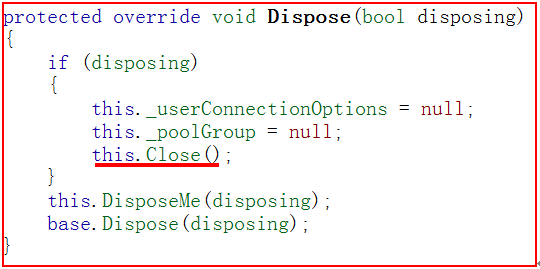1.数据访问层
using的用法:
01.可以using System;导命名控空间
02.using 的语法结构
using(变量类型 变量名 =new 变量类型())
{
}
案例:


03.using的原理
为什么出了using所在的{},会自动回收对象。
原因是当我们将要出{},系统自动调用了Dispose()方法。
而在DISpose方法中是这么实现的

2.哪些对象才可以使用Using回收!如:SqlConnection Font 和File 也都可以使用using 因为他们实现了IDisposable接口
必须实现了IDisposable 接口的类型才可以使用using回收!

3.using回收的是托管还是非托管资源?
解析:什么是托管:所有的C#代码都是被CLR监管,
结论是using回收的是 非托管资源!
2.会实现参数化SQL
解析:username: ' or 1=1 -- pwd:sb
1.使用using释放资源
Using释放的是托管资源还是非托管资源?
解析:非托管,C#应用托管到.NET Framework.但是他可以释放非托管资源。
1.using用法:
01.有人问,什么样的的语句可以使用using管理??
官方人士解析:稀缺的资源,才需要using管理。接着有人问:what is less resource ?例如:Connection对象,IO流。
02.Dispose方法会自动调用Close()
要想让一个类型可以通过using管理,该类型或者父类必须实现了IDisposable接口。
using(SqlConnection con=new SqlConnection)
{
//本质上自动调用了Dispose方法
}
2.close()和dispose()区别?
解析:close()只是关闭连接,但是通道没有销毁,dispose()不仅把连接给关闭了,而且把通道也给销毁了。
2.会使用SqlParameter给SQL传递参数
1.又有人问,菜鸟写的程序,被SQL注入怎么办??
官方人士解析:
01.要想避免,就通过参数的方式,来书写SQL语句
02.通过存储过程,存储过程中使用参数
2.哪些年,童鞋们用过的@
解析:01.数据库中@@error:全局变量
@num:局部变量,程序员自己定义的变量
02.路径转义:@"D:"
03.在SQL语句中进行参数化查询时,可以避免SQL注入
SqlParameter对象
在C#中获取存储过程的返回值
SqlParameter para=new SqlParameter("@myresult",SqlDBType.Int);
para.Dirction=ParameterDirction.Output;
para.Value;
3.会使用ADO.NET调用存储过程,包括SqlHelper类的使用
无参的存储过程
带输入参数的存储过程
带输入和输出参数的存储过程
4.con.CrateCommand()的用法
5.SQL语句中参数化模糊查询写法
解析:like '%'+@name+'%'
private void btnOK_Click(object sender, EventArgs e) { string str = "Data Source=.;initial catalog=MySchool;uid=sa;pwd=6375196"; SqlConnection con = new SqlConnection(str); string sql = "select * from student where studentname like '%'+@name+'%'"; SqlCommand cmd = con.CreateCommand(); cmd.CommandText = sql; cmd.Parameters.Add(new SqlParameter("@name", txtName.Text)); SqlDataAdapter da=new SqlDataAdapter(cmd); DataSet ds=new DataSet(); da.Fill(ds, "Info"); dataGridView1.DataSource = ds.Tables[0]; }
SQL注入
//登录按钮 用户名和密码不对也可以成功登录 //1.1获取到用户名和密码 string uname = txtName.Text; string pwd = txtPwd.Text; //1.2发送SQL指令,拼接SQL方式 string str = "Data Source=.;Initial Catalog=MySchool;uid=sa;"; string sql = "select count(1) from student where studentName='" + uname + "' and Loginpwd='" + pwd + "'"; SqlConnection con = new SqlConnection(str); SqlCommand cmd = new SqlCommand(sql, con); con.Open(); int count = Convert.ToInt32(cmd.ExecuteScalar()); if (count > 0) { MessageBox.Show("成功登录!"); } else { MessageBox.Show("失败!"); } //用户名输入 ' or 1=1 -- 密码输入 :随便输 //SQL Server 查询的语句是 select count(1) from student where studentName='' or 1=1 --' and Loginpwd='sb
为防止SQL注入
//1.1获取到用户名和密码 string uname = txtName.Text; string pwd = txtPwd.Text; //1.2发送SQL指令,拼接SQL方式 string str = "Data Source=.;Initial Catalog=MySchool;uid=sa;"; string sql = "select count(1) from student where studentName=@name and loginpwd=@pwd"; SqlConnection con = new SqlConnection(str); SqlCommand cmd = new SqlCommand(sql, con); con.Open(); SqlParameter p1 = new SqlParameter("@name", uname); SqlParameter p2 = new SqlParameter("@pwd", pwd); cmd.Parameters.Add(p1); cmd.Parameters.Add(p2); try { int count = Convert.ToInt32(cmd.ExecuteScalar()); if (count > 0) { MessageBox.Show("成功登录!"); } else { MessageBox.Show("失败!"); } } catch (Exception) { // throw; }
C#调用带输入参数的存储过程
数据库--->可编程性--->存储过程--->

//开始把Alter改成如下的create create procedure usp_selectInfoOutput @sex nvarchar(32), @count int output as select * from Student where gender=@sex select @count=count(1) from student where gender=@sex return 100
按性别加载数据
在Main窗体中写
//1.1 连接字符串 string str = "data source=.;initial catalog=MySchool;uid=sa;"; //1.2 创建连接对象 呵呵 SqlConnection con = new SqlConnection(str); //创建SqlCommand 对象的第二种方式 //从Con出发 //1.3 从连接对象构建命令对象 SqlCommand cmd = con.CreateCommand(); //1.4 给命令对象需要执行的SQL语句赋值 cmd.CommandText = "usp_selectInfo"; //告诉SQL引擎我传递过来的是 存储过程的名称 //1.5 我们告诉SQL引擎 我通过网线送过去的字符串是 一个存储过程的名字啊 cmd.CommandType = CommandType.StoredProcedure; //1.6 构建存储过程的输入参数,并且给参数赋值, //参数的名称必须和定义存储过程的输入参数名称完成相同 SqlParameter para = new SqlParameter("@sex", "1"); //1.7 将参数和命令对象的参数集合绑定 cmd.Parameters.Add(para); //1.8 打开数据库连接通道真正建立 con.Open(); //1.9 构建一个适配器 )卡车( 对象 SqlDataAdapter da = new SqlDataAdapter(); //1.10 将已经初始化好的cmd对象和da绑定 da.SelectCommand = cmd; //1.11 构建内存中的数据集对象 DataSet ds = new DataSet(); //1.12 从DB 拎 数据到DataSet 中的一张表 da.Fill(ds, "StuInfo"); //1.13 将dgv的数据源指向表 dgvList.DataSource = ds.Tables["StuInfo"]; //1.14 连接关闭 con.Close();
同上
string str = "Data Source=.;Initial Catalog=MySchool;uid=sa;"; SqlConnection con = new SqlConnection(str); SqlCommand cmd = con.CreateCommand(); cmd.CommandText = "usp_selectInfo"; cmd.CommandType = CommandType.StoredProcedure; SqlParameter pare = new SqlParameter("@sex", "1"); cmd.Parameters.Add(pare); con.Open(); SqlDataAdapter da = new SqlDataAdapter(); da.SelectCommand = cmd; DataSet ds = new DataSet(); da.Fill(ds, "Info"); dgvList.DataSource = ds.Tables["Info"]; con.Close();

三: C#调用带输出和返回值的存储过程

在boy's number 的输出:5 在返回值:100 在 学生框中支持模糊查询 在dgvList控件输出查询的结果
数据库--->可编程性--->存储过程--->
create procedure usp_selectInfoOutput @sex nvarchar(32), @count int output as select * from Student where gender=@sex select @count=count(1) from student where gender=@sex return 100
在<调用带输出和返回值的存储过程>窗体里写
//1.1 连接字符串 string str = "data source=.;initial catalog=MySchool;uid=sa;"; //1.2 创建连接对象 呵呵 SqlConnection con = new SqlConnection(str); SqlCommand cmd = con.CreateCommand(); cmd.CommandText = "usp_selectInfoOutput"; cmd.CommandType = CommandType.StoredProcedure; SqlParameter[] paras = { new SqlParameter("@sex","1"), //凭什么 C# @count 输出参数 new SqlParameter("@count",SqlDbType.Int), new SqlParameter("@myreturn",SqlDbType.Int) //返回值 }; //为参数指定方向 paras[1].Direction = ParameterDirection.Output; paras[2].Direction = ParameterDirection.ReturnValue; cmd.Parameters.AddRange(paras); SqlDataAdapter da = new SqlDataAdapter(); da.SelectCommand = cmd; DataSet ds = new DataSet(); da.Fill(ds, "StuInfo"); dataGridView1.DataSource = ds.Tables["StuInfo"]; //填充总人数 txtNum.Text = paras[1].Value.ToString(); txtReturn.Text = paras[2].Value.ToString();
四:模糊查询 在Select控件中写
string name = '%' + "hhe" + '%'; //1.1 连接字符串 string str = "data source=.;initial catalog=MySchool;uid=sa;"; //1.2 创建连接对象 呵呵 SqlConnection con = new SqlConnection(str); SqlCommand cmd = con.CreateCommand(); //1.3 SQL脚本 like后直接跟@name //cmd.CommandText = "select * from student where studentname like @name"; //cmd.CommandType = CommandType.Text; //SqlParameter para = new SqlParameter("@name", '%' + txtName.Text + '%'); //同下三行代码效果一样 cmd.CommandText = "select * from student where studentname like '%'+@name+'%'"; cmd.CommandType = CommandType.Text; SqlParameter para = new SqlParameter("@name", txtName.Text); cmd.Parameters.Add(para); SqlDataAdapter da = new SqlDataAdapter(); da.SelectCommand = cmd; DataSet ds = new DataSet(); da.Fill(ds, "StuInfo"); dataGridView1.DataSource = ds.Tables["StuInfo"];